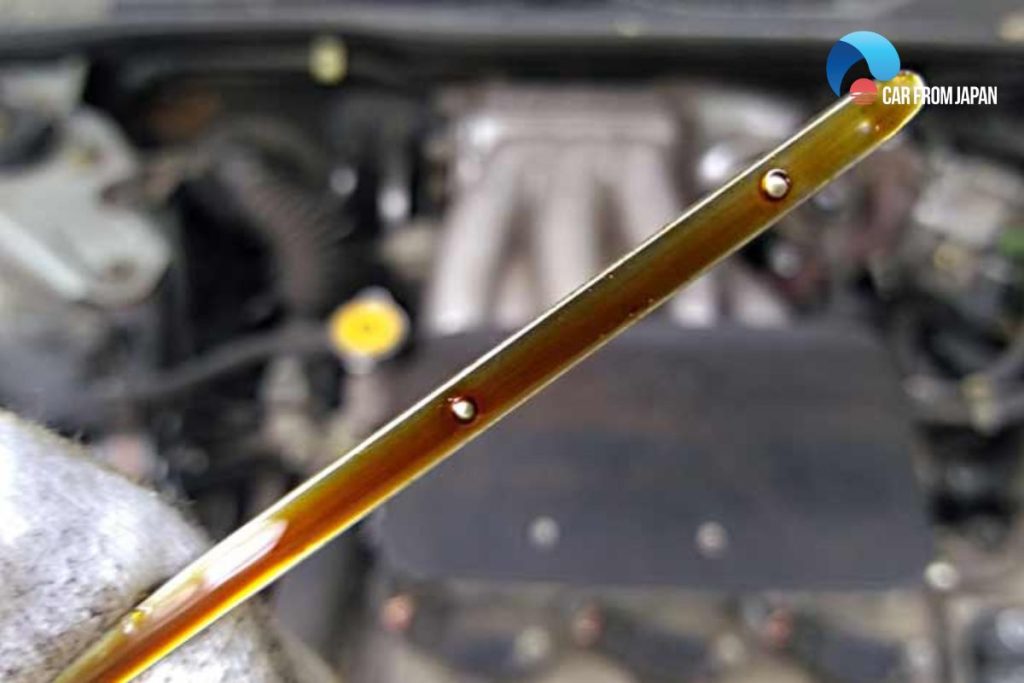With time, as you cover those miles, your car’s engine oil needs to be changed. The engine oil color is an indicator that you can use to determine if it is the right time to change the oil.
Think it like washing a carpet, if the color of the carpet is dark, it tells you the time to wash it. Similar to the engine oil, by checking the bad car oil color, you will know what to do.
Not following the oil changing sessions can cause your car to face some serious damage.
Let’s get to know more about different engine oil colors and how to choose the right time for oil replacement.
Contents
Do You Know The Function Of Engine Oil?
The engine oil helps absorb heat from the engine and lubricates moving metal parts that would otherwise grind together.
When you drive your car, the oil pump circulates oil within your engine and the oil filter catches the deposits that build up over time. The oil filter performs its own type of car maintenance by keeping the oil clean.
However, as the oil gets older, the number of deposits in the oil continues to build and the filter is unable to extract all of the material. When this happens, the color of the oil changes and it indicates the oil should be changed.
Decoding The Different Engine Oil Color
The oil is doing its job, it should be dirty. Oil treated with an effective dispersant suspends dirt, metallic materials, and unburned carbon.
By monitoring an oil’s condition through oil analysis you can establish operating trends to use it as a preventive maintenance tool.
When all the buildup gathers in the oil, it becomes less efficient and not replacing it timely makes it non-working for the automotive parts. Checking the color of the oil is the easiest way to know if it is time to buy new oil.
You can use a dipstick to check what color should oil be on dipstick will help you to diagnose the engine oil.
If you have no idea what is called dark oil, milky oil, or red oil check the car engine oil color chart below. It shows clearly which color is considered black or red.
We are now presenting to you the engine oil color analysis, and what the used oil looks like. You will have deep knowledge about your car engine oil color and at which color, the oil should be changed.

See More: Do you know the best time to check the level of your engine oil?
Creamy or milky engine oil
Sometimes, you can notice the engine oil color as somewhat milky or creamy. Well, it indicates that the oil contains water. It can be the engine’s coolant that is getting into the oil because of the leaky head gasket.
It also happens when you travel short distances, and the engine cannot produce enough heat to burn that water. Instead, it creates water vapors, that get mixed into the oil.
So, a creamy engine oil color does not necessarily need a replacement if it is because of the short trips. You just need to drive the engine enough so those water vapors can get evaporated.
Dark engine oil
If the dipstick oil is dark colored, it tells that the engine oil is in bad condition. Some people consider light engine oil to be clean and dark engine oil to be worn out. However, it is not true every time as dark oil doesn’t need to mean it is worn out.
So when you ask ‘what color should engine oil be’ duration is a factor too. The more months the oil runs, the more deposits it collects.
The darkening of oil color also depends on the engine oil brand as in some brands, the oil changes color in less time.
Hence if you notice the red engine oil or a somewhat darker shade like black engine oil, determine the total months as well for which the oil is running in your car’s system.
Some cars can cover 3000 miles before you need to change the engine oil and some cover up to 5000 miles.
If the engine oil is black, it is considered a bad engine oil color, and there is something serious with the system. In this case, you can take it to a nearby car repair and get to know the issue.
Benefit Of Changing Engine Oil

After checking the car engine oil colour is in bad condition, it needs to be replaced. There are 5 benefits of changing engine oil which you should know. They are:
Make engine cleaner
Changing the engine oil will help to keep car engines clean and running smoothie. As an engine operates, microscopic wear and debris particles flake off from various internal engine parts and enter a car’s oil.
By changing the oil regularly, the engine is ensured bathed and lubricated with clean, quality motor oil.
Make engine last longer
Bad engine oil can lead to the result of engine failure. Therefore regular oil changes reduce engine wear and result in a longer-lasting car engine.
Increase gas mileage
Changing bad engine oil will infuse an engine with clean, quality engine oil that provides better lubrication and friction-reducing capabilities.
By that the engine has less friction, the engine will run easier and smoother, and the mileage is increased.
Reduce emissions
The engine oil is the lifeblood of your vehicle: the fluid that lubricates, cleans, cools, and prevents wear. As you already know changing engine oil will make the engine run cleaner, therefore it will reduce the emissions.
The engine performs better
As changing engine oil makes the engine cleaner, it will perform better than using dirty oil. It leads the engine to maximize its mechanical output.
FAQs on Engine Oil Color
Why does my oil look milky or creamy, even after a fresh change?
That’s often a sign of coolant contamination, possibly from a blown head gasket or cracked cylinder head.
It can also happen with condensation in cold climates over short trips.
Can reddish or pinkish engine oil indicate a problem?
Yes. That could mean cross-contamination with transmission fluid or power steering fluid, especially if you’ve had a recent service mix-up.
Does foamy or bubbly oil mean I need an oil change?
No, it’s more serious. Foamy oil often points to air being mixed into the system, possibly from overfilling, a faulty PCV valve, or internal coolant leaks.
Why does my oil smell like fuel or exhaust?
This can indicate fuel dilution, common in vehicles with leaky injectors, worn piston rings, or frequent short trips where fuel doesn’t fully burn off.
Why does my oil turn dark faster after an engine flush?
Because flushing dislodges built-up grime and deposits. The new oil picks up that residue quickly, which is normal, and may even mean the flush worked.
Watch this video from repairvehicle to learn more about oil changes color!
Conclusion
If your engine oil color is turned dark in the shade and if it smells burnt off when you whiff that dipstick, you can consider it the time to change the engine’s oil.
Always use common sense and not just rely on the color always. Consider factors like total miles covered and the brand name too.
Have a look at the maintenance tips for the automobiles and diagnose all possible problems!



